Issue Number 45, Summer 2019
Contents
- Life is Beautiful by Dorianne Laux
- On the Beach by Linda Casebeer
- Articulating the Bones by Devreaux Baker
- In Praise of Cherries by Karla Arens
- Weather Station on a Plain by Ann Spiers
- Under Mummy Mountain by Robert Ronnow
- Fruit Bats by Robert Coats
- River in a Glass of Water by Robert Coats
- Oldest Mountains by Brandi Jo Nyberg
- Delhi's Weather Report Reads "Smoke" by Anna Citrino
- On the Other Side by Anastasia Dotzauer
- The New Age by Jan Steckel
- On I-95 at 2:28 A.M. by Dorsía Smith Silva
- Almost Storm by Richard Schiffman
- Boy with Watercolor Hair by Lis Sanchez
- Least Terns by Lis Sanchez
- Dream by Dermot O'Sullivan
- Coyote by Cameo Marlatt
- My Red-Tailed Hawk by Dan Cardoza
- Cubicle by Anthony Borruso
- Cry for Help by Sean Tierney
- Lament for the Flowering Pear Tree by Susan Kelly-DeWitt
- Close to Home by David M. Hoza
- Salina, Kansas by Gene Berson
- By August by Gene Berson
- Pebble Creek, Montana by Ingrid Keriotis
- Walking at Night by Elizabeth Poliner
Archives: by Issue | by Author Name
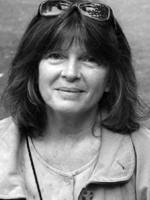
Life is Beautiful
by Dorianne Laux
Dorianne lives in a neighborhood of Raleigh, NC, which was once a pecan grove and you can see vestiges of them in patches all around the neighborhood. She has a paper bark maple in the front yard that sheds full legal-sized sheets of bright red bark year round, a flowering dogwood, and smooth-barked crepe myrtles that line the street. In the backyard a shaggy 60-foot cedar towers above the house.

and remote, and useful,
if only to itself. Take the fly, angel
of the ordinary house, laying its bright
eggs on the trash, pressing each jewel out
delicately along a crust of buttered toast.
Bagged, the whole mess travels to the nearest
dump where other flies have gathered, singing
over stained newsprint and reeking
fruit. Rapt on air they execute an intricate
ballet above the clashing pirouettes
of heavy machinery. They hum with life.
While inside rumpled sacks pure white
maggots writhe and spiral from a rip,
a tear-shaped hole that drools and drips
a living froth onto the buried earth.
The warm days pass, gulls scree and pitch,
rats manage the crevices, feral cats abandon
their litters for a morsel of torn fur, stranded
dogs roam open fields, sniff the fragrant edges,
a tossed lacework of bones and shredded flesh.
And the maggots tumble at the center, ripening,
husks membrane-thin, embryos darkening
and shifting within, wings curled and wet,
the open air pungent and ready to receive them
in their fecund iridescence. And so, of our homely hosts,
a bag of jewels is born again into the world. Come, lost
children of the sun-drenched kitchen, your parents
soundly sleep along the windowsill, content,
wings at rest, nestled in against the warm glass.
Everywhere the good life oozes from the useless
waste we make when we create—our streets teem
with human young, rafts of pigeons streaming
over the squirrel-burdened trees. If there is
a purpose, maybe there are too many of us
to see it, though we can, from a distance,
hear the dull thrum of generation's industry,
feel its fleshly wheel churn the fire inside us, pushing
the world forward toward its ragged edge, rushing
like a swollen river into multitude and rank disorder.
Such abundance. We are gorged, engorging, and gorgeous.
Dorianne Laux, "Life is Beautiful" from Smoke. Reprinted by permission of BOA Editions, Ltd.
© Dorianne Laux

On the Beach
by Linda Casebeer
For the past twenty-five years, Linda has lived under a canopy of 100-year-old trees in the Cahaba River Watershed near the end of what-many-consider the oldest mountains in the world.

Everyone who could was driving away
from the cities everyone who could
was driving towards the oceans
and away from what radiated
Phillip Glass played piano for the film score
etudes that repeated unlearned lessons
everyone who could was driving away
from the cities water was everything
a woman POTUS not Hillary
had precipitated the chaos a woman
who wanted to appear tough answered
a simple attack with nuclearity
that night everyone who could was driving
towards the oceans under the stars
that night everyone who could was driving
away from the cities the country had shrunk
somehow the girls were young again
I drove the old blue station wagon that night
everyone who could was driving away
from the cities I drove in a line of cars
until we reached a dead end in the middle
of a congregation sitting in pews
staring straight ahead gently waving fans
from a funeral home to cool the humid air
electricity was gone everyone who could
was driving anywhere to buy gas
knowing we would run out after we had fled
the city I turned the wagon around towards
home and wondered what to do about water
since water was everything we could set out
pans to catch rain the way I had learned
as a child to catch rainwater for rinsing
hair soft and silky but would the first rains
be radioactive we had never stored water
or canned food for emergencies the stores
had closed after their windows were smashed
neon electric no longer mattered batteries
and bottled water gone no medicine
the girls were young and healthy for the moment
but they would need water where were the bomb
shelters the concrete geodesic domes
the soothsayers of the millennium warned
us we would need water when the end came
how could we exist eating handfuls of berries
from nandina bushes bark and root
while we waited for the acorns to fall
from the hundred-year-old oak
we had only grown ornamentals not
homesteaders we had no guns no way to fish
when floods had forced koi from their ponds
in the Botanical Gardens the koi had floated
away downstream nets had to be set as traps
we could walk the few miles there
and find a way to net the koi but the girls
would argue they should not be killed
on this earth where radioactivity was set
to spread until all skin burned
where was the cyanide to alleviate suffering
the way the etudes repeated everyone
who could was running frantic for more
in the dream water was everything
and the girls were young again
© Linda Casebeer

Articulating the Bones
by Devreaux Baker
Devreaux lives on the coast of the Pacific Ocean in the Big River Watershed.

They brought her in cardboard box-loads
what once had been a great blue god
dreaming oceans with her fins and filled
with the aftertaste of rivers in her blood.
Now she is returning to the land,
laid out vertebrae by vertebrae
on the floor of a make-shift lab
in the town’s community center.
We kneel over her to recreate a life
determined by current and wave, by moon
or the machinations of men.
We place her bones in a shape
water will recognize as one of her own
and call her wandering spirit back
to that soundless deep
even as I teach my daughter
how in death a voice can arise and speak to us
is able to reach across that wide plain
that separates the living and the dead
to help guide us into our own uneasy future
This is called articulating the bones
the lab technician says. But I know
he is opening Neruda’s blue door
releasing consonants and vowels
of hopeful sorrow, defining a body
by loss or gain, the color of skin,
luck of the draw, or that inexplicable moment
that creates the journey of a life-time.
I tell my daughter we are waking
the great blue whale, pulling her from
her deep sleep
resurrecting a life as mysterious and ancient
as our own, opening the blue door
stepping into the house
we all share.
Previously published in the author’s collection Hungry Ghosts, 2018.
© Devreaux Baker

In Praise of Cherries
by Karla Arens
Karla Arens lives on the western slopes of the Sierra in Deer Creek Canyon.

Cherries. Plump Bing cherries. Fat wild cherries almost blueberry blue. Neighbor children giggling high on a limb of the old cherry tree, lips and small hands stained a sticky fuchsia. The soles of our bare feet tinged crimson from trekking through cherries littered by the kitchen door. Jars of cherry jam thickening on the kitchen counter. A few precious bottles of wild cherry juice beginning its ferment in the dark of the pantry and a sweet cherry pie cooling on the windowsill just as we have always desired.
The cherries made gluttons of us all. And for a moment or two in the palpable summer heat and dizzying happiness of buckets of cherries and good fortune, I imagined us, not as the tan California family in shorts and t-shirts on a hot summer day that we were, but as characters from some other time or place with women in pale, long dresses lounging on the newly mown lawn, cheeks flushed and full lips rouged with cherry juice, and the men in white linen suits and straw hats lifting their children to pluck from the tree. So passed the longest days of the year, the opulent month of June.
That summer turned out to be the last time my old cherry bloomed with such abandon. Even then in those heady days, I couldn’t entirely push away the suspicion that the bounty bestowed upon us might be a worrisome symptom that the tree’s life force was waning and that the generous flush of fruit was the tree’s last chance to pass on its marvelous attributes through a copious quantity of seeds. This thought proved to be sadly prescient as next season the tree barely bloomed and the fruit fell before ripening. We did what we could to save it. We pruned the dying limbs and watered, held back water and hugged. In the end, age proved an indomitable force to which we finally yielded and cut down all of what remained of the tree.
My neighbor, who at that time was in her late eighties and whose family lived on what had been a mining claim for at least four generations, told me that our cherry was the last one remaining of five that had been planted in the 1800s. Apparently an aspiring young miner thought this site a good place to settle knowing (hoping) that not only was there gold in Deer Creek just down the hill but also good soil and sun on the knoll. He had carried with him on a train from Pennsylvania five seedling Bing cherries wrapped in burlap, the offspring of an older grand cherry under which he had kissed his sweetheart adieu as he started West. I like to think that she caught a later train and followed him with a satchel of her own filled with cuttings of lilac sprigs and pink garden phlox, whose wild progeny still blossom along our stream beds in early spring. By the time our miner finally arrived there wasn’t much gold left for him in the creek, but the saplings he had so carefully carried across the continent grew to a girth of seven feet in the loamy topsoil that was the gift of an old forest long ago harvested.
The stumps of the other four trees took some digging to find. The forest was consuming the old orchard, and they were buried under a pungent tangle of kitkitdizzi and pine needles. Our woodland was then and is now speckled with slender cherry saplings that for a few weeks in summer provide a tart feast for the birds that inhabit this watershed. Even though so prolific, it was hard to imagine that they could ever achieve the stature of their parents, whose remnants, even so many years after their demise, remained a decomposing yet enduring source of nutrients for the fungi and beetles that permeated what was left of the porous bark.
The fortunes of our cherry festival would not come again, but sometime around the winter solstice, I remembered the bottles we had tucked away on the back shelf of the pantry. We were primitive wine makers at best and our simple method consisted of layering fruit and sugar with a sprinkling of yeast. One of the jars had cracked, but the scarlet juice in the others had fermented into a deep claret. In the late afternoon of a December day we found just enough liquor to fill our glasses a time or two with the taste of a languid summer day, the nostalgic sweetness of wild cherry wine.
© Karla Arens
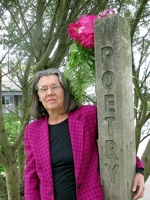
Weather Station on a Plain
by Ann Spiers
Ann lives on Puget Sound in Vashon Island's Ellisport Creek watershed.

My dad discovers gold in an aerosol can.
Like Midas, he gilds all. The ozone thins.
I ride my golden bike, my skin bronzing
under the ultraviolet rays of the sun.
Above my poem, “Weather Station on a Plain,” is an icon from the International Weather Symbols. This poem belongs to a cycle in which the poems also use symbols from the same coding system. These symbols exist for many categories depicting the surface weather, such as the other types of weather stations (Deep Valley, Coast, Plain) and those that show the amount and intensity of drizzle, fog, rain, and thunder. My hope is that the symbols inject each poem with depth, counterpoint, and link to specific climate phenomena as the poem details today’s climate crisis.
The International Weather Symbols are the visual code used to map surface climate conditions observed at local weather stations worldwide. The World Meteorological Organization (WMO) oversees this coding system. The data illustrated include cloud type and cover, temperature, precipitation, wind speed and direction, atmospheric pressure, precipitation type and amount. Plotted on a page, the visuals use a prescribed placement of symbols outside a central circle to record surface weather conditions at one time and one place.
The complexity of the maps ranges from eight to many notations, depending on the station’s purpose and instrumentation. Observations are made once or twice a day or, given today’s capabilities, second to second.
These stationary weather stations, numbering in the tens of thousands, are sited in citizen scientists’ backyards and fields, on sea buoys and ships, and at universities and meteorological institutions. Making further data available for surface weather maps are today’s computer systems and software, affordable instrumentation, open reporting systems, satellites, and GIS. Weather hobbyists have always been the most numerous data recorders and sharers. The data are used for research as well as by airplane pilots, sea captains, ground transports, and citizens to chart the safest course.
In the mid-1800s, inventors added to the collection of instruments measuring weather. This growing ability to gather weather data was available and affordable, as it is today, to both amateur and professional weather watchers. In the 1840s, weather watchers used another new invention, the telegraph, to transmit observations to regional, national, and global agencies. Combined, the data produce weather maps of wider geographical areas. With the new source of data, newspapers printed weather maps; weather forecasting emerged from the compilations. By 1941, global consensus was reached on the symbols and their meanings. On-line now, numerous networks collect the surface-weather reports.
Today globally, surface-weather maps indicate that climate warming occurs based on the local weather stations’ very local data. Debate rages about the data’s accuracy from the thousands of worldwide stations.
For an example of the weather station maps, see https://www.wpc.ncep.noaa.gov/html/stationplot.shtml
© Ann Spiers

Under Mummy Mountain
by Robert Ronnow
Bob lives in the Hoosic River watershed, a tributary of the Hudson River. He observes streams hurrying or hesitating toward the Hoosic, and an occasional black bear, porcupine, barred owl or pileated woodpecker, during his morning rambles in the Taconic Mountains.

Aspen, ponderosa pine, blue spruce
pink glacier-cut rock, scree, ravens
gray jay, peregrine falcon, hawk.
We climb to 11,000 feet in three days,
camp at Lawn Lake for three days. Alpine
tundra. Elk, bighorn sheep, marmot.
Tileston Meadows, ticks in grass,
rock face of Mummy Mountain.
Binoculars show pink cracks in gray rock.
Stoke gas stoves, play cards.
Boil water, set up tarps, lay out
sleeping bags, hang bear bag.
Watch crescent moon slice into
Fairchild Mountain. Moonlight
makes a mosque of the rocks.
Yellow aspen splash in dark green
spruce and pine. Gullies where streams
slash during spring snowmelt.
One rock, feather or flower worth
more than money. Need no wallet,
keys. Just clothes for fur.
All day climb toward saddle to see
what’s on other side. One hawk floating
among bare peaks and over valleys.
Wind at 13,000 feet
turns to sleet. Turn back from peak,
take boulders two at a time down.
Winter moves into mountains.
Then we fly from Denver to New York
where it’s still summer.
© Robert Ronnow

Fruit Bats
by Robert Coats
Bob lives in the watershed of Blackberry Creek, a small urbanized but partially-restored tributary of San Francisco Bay. He may also be found occasionally in the Tahoe basin, where he is studying the impacts of climate change.

I thought they were crows
black wings flapping
flapping against the red sky,
then saw stubby tails,
clawed wings, and knew:
flying foxes!
I followed their screeching
to nearby gum trees,
watched them creep through the canopy,
vulpine faces snuffling white blossoms.
How did these creatures ever become
the stuff of nightmares and horror flicks?
Once they darkened the skies
over North Queensland,
setting off to forage
in fruited tracts of rainforest,
pollinating flowers, spreading seeds
in groves since burned for sugar cane.
At dawn they return
to squabble for a good perch,
hang upside down
wrapped in leathery wings.
Branches of eucalypts heavy
with furry dark fruit.
© Robert Coats

River in a Glass of Water
by Robert Coats
Bob lives in the watershed of Blackberry Creek, a small urbanized but partially-restored tributary of San Francisco Bay. He may also be found occasionally in the Tahoe basin, where he is studying the impacts of climate change.

In late summer, when reservoirs are low
the tap water carries
a faint fishy and algal smell.
My wife complains, but to me
it is the smell of the Potomac,
and the summers of my childhood.
The trail led downward through
patches of stinging nettle,
jewel-weed with juice to cool the sting,
through dark and humid woods,
willow thickets,
to the river’s sandy bank.
We’d hop from rock to rock
to reach mid-stream islands,
bait our hooks with fat worms,
to try for wriggling catfish.
In spring, shad in the millions
ran up the river.
And high overhead
gulls in great flocks
wheeled and mewled.
© Robert Coats
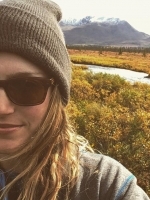
Oldest Mountains
by Brandi Jo Nyberg
Brandi Jo Nyberg lives 200 miles south of the Arctic Circle in the Tanana River Valley, a tributary of the Yukon River. She has spent the past several years migrating from river to river and misses Appalachia's New River the most.

Today I was a raft guide. The Upper New River in beautiful West-By-God-Virginia. Mostly flat water with ripples and rocks here and there, ending with two class III rapids. An easy section of river. Today, I had the pleasure of rowing.
It felt great to row again, as it had been a year since I rowed down a stretch of river. Initially, it burned. But once I worked through the burn it felt glorious. Satisfying.
The first of the class III rapids on this section is called “Surprise,” because if you follow the beautiful glass tongue down the center of the rapid, you are tricked by the water and end up running the “meat” of the rapid. In this case, guess what that means? Surprise! You’re probably going for a swim. Also, your boat may be upside down. Luckily, I managed to row the boat slightly to the left center of the hole. This is lucky because what I did not manage to do was straighten the boat out, and I dropped into the hole sideways. Had I been in the center, my boat probably would have flipped. Novice mistake. I’m going to blame it on my out-of-practice rowing arms.
Most of the trip I rowed alone, carrying our lunches, everyone else – customers and a few other raft guides – in duckies (inflatable kayaks). I rowed ahead or behind, relaxed, and gazed at the lush, deep green mountains that rose up out of the river. Compared to mountains of the Western U.S., they seem small. Time and erosion have softened these peaks. When I am wrapped in West Virginia’s mountainous arms, I feel at ease. At home.
Why?
Why do only these mountains of Appalachia make me feel it?
Is it my West Virginia heritage, my family ties? My mountain blood knows its home?
Or is it a comfort drawn from something deeper?
Can my body and emotional self somehow sense how old and wise these Appalachian Mountains are?
Some of the oldest there are, that’s how old. Four hundred and eighty million years old, old.
*
The Appalachian Mountains once rose higher than the Rockies, the Alps, the Andes, and many scientists believe they were the first of their kind. The first, ever. On Planet Earth. And the New River, well, contrary to its name, is even older than the mountains. Could one place monetary value on a natural history such as this? Industry can.
Once upon a time, this region was a swamp – near the equator – rich in plant life different from that of the present. Massive trees and ferns and muck all dying and forming a thick layer of peat. This incredibly carbon-rich peat was slowly covered by layers of sediment, accumulating little by little, year by year. Then some tectonic plate shifting. Then some tectonic plate slamming, continental uplift, and the peat became buried. Buried under lots of pressure. Peat then turned to lignite (the lowest ranking, ‘softest’ coal), then with some more high pressure to sub-bituminous coal, then bituminous coal (or, soft, black coal), then anthracite (the hardest coal with the highest carbon content, the fewest impurities, and the highest energy density). This biological and geological transformation was a slow one. The conversion from peat to anthracite coal takes place over millions of years.
The coal of Appalachia is of the bituminous type – relatively soft and containing the tarlike substance bitumen, or asphalt. Historically this coal was mined by many men underground in tunnels and cave-like spaces. As technology progressed, mining companies realized that instead of burrowing into the mountain side, the top of the mountain could simply be scraped off.
Surface mining, which includes strip mining, open-pit mining, and mountaintop removal mining, was a different kind of beast. In 1977, when the Surface Mine and Reclamation Act was put into place, strip mining was permitted in Appalachia but only if the land were reshaped afterward to be “as close as possible to its original contours upon completion of operation.” However, this act made no specific references to mountaintop removal. The result was a legal loophole through which mountaintop removal operations continued to function. These mountaintop removal mining operations use explosives to break up the mountain’s rock layers above the coal and then scrape off the tops of the oldest mountains in the world– scrape them flat. They extract the coal. They make no effort to reshape the mountain to its previous form. What is left: a manmade dustbowl, a hidden sort of collapsed colosseum. Hard, barren edges carved out of what was once a soft, prolific peak. Over 480 million years of geological evolution scraped flat in a matter of months.
Instead of “reshaping” the mountain to its “original contours,” the tops are left leveled, a white eyesore against the green slopes. The excess rock from the scrapings and explosives are usually pushed and dumped into adjacent streams, hollows, or valleys. There is no effort to contain this casualty. The result is the death of a stream. Ecosystems lost. Nutrient cycling and food webs disrupted and destroyed. Poisoned. Several West Virginia watersheds already have at least 10 percent of their total area affected by mountaintop removal. The EPA has found that more than 90 percent of Appalachian streams below valley fill sites (the “nice” term used for the dumping of excess mountaintop removal materials) were affected, according to the Clean Water Act’s standards. The valley fill sites appear as a giant staircase from the mountain hollow below but act as a slow seepage waterfall.
How long will it be before the New River, believed to be one of the oldest rivers in the world, is destroyed? Sure, some of the River’s course in West Virginia is designated as a National River under the U.S. Park Service, but the Ohio River Watershed which contains this river is huge. Of the approximately 360 miles that encompass the New River’s path, only 53 of them are the New River Gorge National River section.
*
When I am alone in a boat on the New River, my mind leaves the water and floats up to the flattops – the mines beyond my sight. Thankfully, the river always manages to bring me back. Shortly after Surprise, I was steadily approaching the second of the class III rapids: Big Bologna, actually a very easy rapid to maneuver through, but rated so because of two river features that must be avoided: Plow Rock and Big Bologna Hole. Plow Rock (also called Pyramid rock because of its shape and size): like any snow plow on the road, you don’t want to collide with it. Running into Plow Rock would most likely result in wrapping your inflatable raft or kayak around it. To avoid this rock, you enter the rapid on river left. After passing Plow Rock you ferry your craft over to river right. Then you straighten her out and head toward center-right, avoiding Big Bologna Hole and many unforgiving rocks on the left, as well as the shallower waters of the right. This sounds complex and difficult, but I promise you – it is not. We send inexperienced people out in their own personal duckies urging them to, “Follow me! Point your boat upstream and ferry to the right!”…they usually make it.
Like many rapids on numerous rivers, there is a tall tale behind the name of Big Bologna Rapid. Long ago, a raft was carrying the cooler filled with everyone’s lunch: West Virginia steak – known to outsiders as bologna. The large and easily avoidable hole got the best of that raft, and all the bologna sandwiches met their fate at the bottom of the river.
I went last through Big Bologna, running my boat as sweep. If any unsuspecting novice fell out of or flipped their ducky, I came in behind them, tidying up the mess. Our group passed through Big Bologna unscathed (as usual).
Back in the hypnotic flat water, my mind wandered to last summer. My bathing suit, which formed a large X on my back, soaked in the New River water, and rubbed up against my skin under my tight PFD (personal flotation device). The result was a rash, my back marked with a big X. I scarred slightly and the X remains. That year, there was apparently an incredibly high level of zinc in the New River. What else had made its way into the water?
Part of the difficulty in predicting and studying what will be washed away into the watersheds surrounding mountaintop removal is that every coal formation is different in terms of chemical makeup. Some have high selenium, some don’t. Some have high arsenic content, some don’t. Manganese. Lead. Iron. Hydrogen sulfide. If it’s on the periodic table, there’s a chance of it being in a coal deposit. Whatever is found in the coal deposit mined by mountaintop removal inevitably makes its way into the water.
*
Although mountaintop removal is now the dominant driving factor of land-use change in the central Appalachian region of the U.S., somehow the unemployment rate of coal country doesn’t reflect this.The miners complain. Bring back coal! they plead to the politicians. Friends of Coal, reads a sticker on the back of a rusty pickup truck. Clean coal, say all of the coal companies’ media sources. Coal keeps the lights on! reads a sign in someone’s yard. We NEED coal.
But the problem is not that consumers no longer need the coal; it’s that the coal companies no longer need the miners. The miners have been replaced, their jobs stolen. By machines. The coal industry has figured out how to get massive machines to do the mining, rather than thousands of men. Mining will never be what it was back in coal country’s heyday. Coal country will never be the same; a way of life is lost. The mountains, too, will never be the same. The oldest mountains in the world.
This way of life is not necessarily a bad thing to have been lost – miners worked dangerous jobs (an estimated 95,000 miners died in the U.S. between 1900 and 1950), long hours, and were historically indebted to the company store. The loss of this lifestyle could present an opportunity to the region; unfortunately, this is not yet the case.
The miner families perhaps don’t see how they are being robbed by the industry. These industries are not bringing life, but death, into their towns. Residents of coal mining areas, especially in Appalachia, generally have greater socioeconomic disadvantages – a polite way of saying they are poor. Their mountains and hollows and valleys and streams suffer greater environmental degradation. Their health suffers, either from working in the mines or pollutant runoff in the water. People die younger here. Minden, West Virginia, a town I drive through every day to reach the river, has a cancer rate of four times the national average.
The politicians of the region claim these flat-top mountains now hold a higher value compared to when they remained peaks. “A lot of people through the years ask why Appalachia is so poor. One of the biggest reasons is we were land poor– we didn’t have any place to build…” Now the flattops are open for development: for subdivisions, for golf courses, for prisons. The oldest mountains in the world – well, now they’ve been scraped flat. And now they’re worth something: $$$.
*
Is there some subconscious part of me (or conscious, perhaps?) that feels comfort in knowing this is the oldest mountain range in the world? Like a wise old grandmother who knows best? (If only she could control her own fate.)
I looked up from the glassy water ahead and stared at the mountains that enclosed me. They appeared wild – untouched. But there is a rich history within those hills. I know that today I rowed past abandoned mines, old coke ovens, mining camps disintegrating back into earth. The old ways, lost to the forest. How long will it take for the earth to reclaim the flattops that ranged just beyond my line of sight?
West Virginia, I return to you and it feels as if no time has passed – even though your mountains have seen millions and millions and millions of years pass. Four hundred and eighty million years. You welcome me, always, wrapping me with your grandmother-like mountains. The place I feel most at home. Where my heart always is – beating – within and for those mountains. Today, here on the New River, I weep for you.
© Brandi Jo Nyberg

Delhi's Weather Report Reads "Smoke"
by Anna Citrino
Anna grew up in the San Diego River watershed. She taught abroad for 26 years in six different countries. She currently lives at the edge of Moore's Creek in the San Lorenzo-Soquel watershed of Santa Cruz County.

Paint fumes and Hexol, natural gas, pesticides,
and the smoke of burning excrement
choke the air. The room’s fan blades fling
poisons in all directions, hoping to cast out
dust demons but soot continues
collecting in the room’s far corners—
granulated clumps of waste and sorrow
no sweet air can lift out,
no sponge scrub clean.
Here there is no sound of gnashing teeth.
No one screams against a paradise lost.
Hieronymus Bosch cannot be found
painting the tortures we’ve made
inside this fumigation cubicle. Sediments
spin out—the karmic wheel of chemicals and dust
colliding in new combinations—but the world
simply churns silently on, suspended particulates
growing as they gorge on air.
Monsoons come. Rains howl. Torrents
beat at my door and the living room floods.
I peer through the window glass, hoping
for a wind that can blast canyons of current
across this breathless plain. I pray for oxygen—
for gallons and gales of air to plunge across the city
like a tsunami—wild rivers of stratosphere
to flood the clogged roadways, pour through
the market’s twisted streets, overflow the boundary
of every tidy convention and choking habit.
We could rise up from our beds then, turn
from our work wheels and our burning,
push away the cogs and cobs. We would breathe
in, and in.
Like the mists of cloud, we would be
caught up into the air.
Become air. Just for a moment.
And when we breathed out,
the whole world would sigh—
would look up into the heavens
and whisper,
“Blue.”
© Anna Citrino

On the Other Side
by Anastasia Dotzauer
Anastasia lives at the base of the Wasatch Range in the Mill Creek River watershed. She is surrounded by cottonwood, aspen, and boxelder trees that are filled to the brim with robins and woodpeckers.

Last year, my father knitted a wire
fence around our house and three others—
a rust-brick block trussed by steel.
Its gunmetal gray fades to dappled
lilac as the sky shifts from shadow to sun.
At night, it clicks and creaks as
if answering his evening prayers.
But no fence—gray, white, or dun will
steady my father’s blind-eyed fears.
He thinks a thin braid of metal and
posts thick as a man’s wrist can seal
the leak—keep wild hands and
bluegrass from creeping in. But
there’s a secret space for leaves to settle,
for weeds to peak. Bushes slide
through the cracks, twist in shapes
he thinks natural, tendril gently over the
lipped fence end. But the way green
slips through seams is anything but
natural. Whatever he’s caged in is
a human thing. Whatever unnerves
him is the earth—a slow-growing
clover lifting from under our feet, forever
slicking our soles as we walk through
the wire gate opening toward home.
© Anastasia Dotzauer

The New Age
by Jan Steckel
Jan lives between Peralta Creek and Courtland Creek in the East Creek watershed, between the Hayward Fault and San Francisco Bay.

Fishermen land sharksicles off Cape Cod.
Frozen iguanas like blighted oranges drop
from Florida trees. Down under,
heat wave boils bats’ brains in flight.
Flying foxes litter the ground like baseballs
at batting practice. A subtle moon watches.
Bayous dry up, forests conflagrate,
floods flash, mud slides from mountains
to ocean. A brown bear frozen mid-roar
paws at nothing, dead on the beach,
washed there from the National Forest
with twisted cars and splintered trees.
The freeway is a river of muck over pieces
of people. Gas fires light the night
from broken pipes. Boil the tap water.
Hoard spices and oil. Grow your own food.
The age of cities is coming to its end.
Previously published in the author’s book, Like Flesh Covers Bone (Zeitgeist Press, 2018).
© Jan Steckel

On I-95 at 2:28 A.M.
by Dorsía Smith Silva
Dorsia lives in the Río Piedras Watershed, which also goes by the name of the San Juan Estuary Watershed.

They own the road,
trotting beneath yellow lights,
breathing wild-eyed,
fierce, and brave.
How they dart zigzag
between the cars
like bouncing pennies
along the asphalt.
Here, they roam
past the ladder of medians
with an easy sashay
over ripped concrete.
Like some newday spirits coming,
they spread out fanlike,
pant and stare,
rushing past the metal thickets,
nourished by the marrows of dark.
© Dorsía Smith Silva
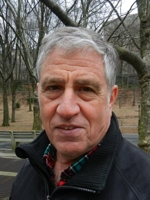
Almost Storm
by Richard Schiffman
Richard splits his time between New York City (where he works as a journalist) and New Mexico (where he writes poems and hangs out with friends and assorted other sentient beings).

Like a cart lumbering down
a rutted track
on steel-rimmed wooden wheels,
we hear the rumble long before
the wind picks up, the cold drops
slap.
But this one cracked an axle
halfway here,
spilled it’s load of pumpkins
on the road.
We watch
the tentacles of walking rain
peter out above our
baking plain.
Some far-off zig-zag bolts
as blazed as stars;
a curlicue of smoke
from trees alight.
All stillborn sound and fury
signifying
drought.
© Richard Schiffman

Boy with Watercolor Hair
by Lis Sanchez
Lis lives in a wooded neighborhood of a metropolitan area inside the Catawba River Watershed. Poplars and old oaks tower above her home, which looks down on a backyard ravine with a dry creek that supports deer, coyote and fox.
Down shore, another tern
listing on the tidepool tilt,
headless
one wing waving, tremulous,
good-bye good-bye
Thirty strides, another headless bird, then more
strung between strands of kelp
at equal intervals,
as though in sympathy with some aborted plan
From pool to pool a red pail leaps—
small arms flashing like shiners
A boy’s head burns
a shivering yellow
like a watercolor sun
When I was small a red octopus sprang from these rocks
after a kelp-colored crab
Its tongue crushing the shell sounded like your teeth inside your heart
Knee-deep, the boy clatters his rabble of hermit crabs—
Pink fingers churn and lift the shells to the sun—
their whorls glow like young ears
eyeballs waggle on short stalks, knuckled legs
Then my shadow darkens
his watercolor hair
Words written on many signs
fall from my mouth,
marring his gladness
As if he understood algal blooms
and why we mustn’t trouble
the sea’s creatures
Red blossoms savage his cheeks
I’m not even touching them, he explodes,
fists thrashing the water’s face
— a swinging of snot
His shrieks swing like gulls grabbing up small claws
hurling one after another
at my feet
From the bluff, looking down at the bulge —
harbor seals bank like dark cumulus
not rumbling — shaking with seizures
What good is looking back
to see if the boy is splashing his noiseful pail
as though each creature were clamoring simply for his joy
as though the tide’s roar were his own
endless companion
and the least treasure caught in his fist
worth fighting for?
Beside him I am a grain of sand.

© Lis Sanchez

Least Terns
by Lis Sanchez
Lis lives in a wooded neighborhood of a metropolitan area inside the Catawba River Watershed. Poplars and old oaks tower above her home, which looks down on a backyard ravine with a dry creek that supports deer, coyote and fox.
Down the bluff to the crystal pools
into the starry nave into the garnet claws
into the urchin’s silver spines
moving down the downshore tilt
a tern wracked in the black stone tide
undulates in her torn gown
she has no head
she has no head and must recall
her way by trailing coral feet across the tilt
a second bird she has no throat
she has no throat and has to pipe
through wormholes in her bones
another dead against dark stone she has no wings
she has no wings and glides and slaps
breast-up across black rock
twisting on the beating tilt she has no wings her wilted gown
her coral feet she can’t recall her bones must pipe
pearlescent orb she glints
repeats repeats so many pearls the sea blinks
the sea can’t stop all that we do
the sea repeats the pearls repeat
the sea laves its hands of us
it takes us back it gives us all its treasures
we give nothing
when the sea has nothing left to give
it gives again if only our dread charms
across its jilted heart

Previously published in Journal of Wild Culture, March 2018.
© Lis Sanchez

Dream
by Dermot O'Sullivan
Dermot lives near the extreme edge of Tijuca Forest, where it stretches across the hills into the city. He grew up close to where the Owendoher joins the Dodder River.

One day the rainforests will return. Briefly they have been knocked back, chased up into the mountains that loom over the city, but one day this backwards movement will reverse and the inevitability of vegetable gravity will descend upon Rio de Janeiro with its full, murderous, green force.
Now a concrete-choked metropolis stinking with 12 million lives, then a barren wasteland of hollowed-out high-rises and deserted streets. The forests will return soon after, trees will tear up the asphalt, dragging the guts of the city — the sewers, the wires, the drainage pipes — up into the open light of day. Trees will clamber up the stairs of abandoned skyscrapers, swarm through the open-plan offices and punch out the windows, drooping like lolling tongues out into the void, dropping fruits and seeds back down into the streets, bringing to a boil the botanical turmoil below.
Whole neighborhoods will become impassable, overrun by finely-woven mato, thickets of thorny bushes over which the soft filaments of lacy creepers will expand like tentacles of ice on a freezing puddle. Snakes and spiders and rats and mosquitos and cicadas will multiply. But no one will recoil in disgust, no one will hear the whine of a bloodsucking malarial fly, none will stop to bask in the revving, trilling insanity of flocks of fat locust roaring at the dying sun. None will chance upon the dried out corpses of these insects’ former incarnations, glued to some exposed branch. No soft feet will be bitten by venomous cobras, that old story will be long gone and long forgotten.
The favelas will disappear first, close to the forests as they are, the shacks flimsy, easily exploded by eager trees rupturing their meagre roofs, the bricks of the walls effortlessly dismantled by figs prising their roots into the interstices of crumbling, poor-quality cement. The churrasqueira of the dealers will contain the nests of small mammals. The old communities will be reduced to plant-swollen piles of rubble before being swallowed entirely by the greed of the rainforest. The slopes of the mountains will be uniform green once more.
The lower and wealthier districts will take longer, many further from the forests or at least more sturdily built. But even in these places it is only a question of time: now or later, sooner or less soon. In Copacabana, on the narrow streets of high-rise apartment blocks, trees will perhaps shoot out of the opposite windows of former sitting rooms and let their branches meet and mingle above street-level, creating a bridge of dense, lush canopy across which the marmosets and capuchins will wander back and forth, safe far above the dangerous, snake and jaguar infested forest floor. The sky-paths over the years will multiply until it will be possible to voyage from Leme to Duque de Caxias without ever setting foot on the ground, of which not an inch will be free of a layer of rotting plant detritus soon to become pure and healthy tropical soil.
Toucans will flap everywhere. Forest dogs will roam by day and by night. Herds of capybara will graze on Praça Tiradentes, oblivious to the many drunken nights that once festered in the surrounding alleys, the young people dancing, the rolling drums, the whores, the addicts, the cans of Antarctica passed back and forth until the beer would get warm and vile. No trace of these voices will reach the ears of these giant rodents as they chew grass loudly and mate and scatter startled at the first sign of danger. For many years, many, many years, the interiors of the grotty barzinhos will persist, the No Smoking sign slowly peeling from the wall, the tiles cracking throughout the decades of brutal heat, ceiling tiles falling in and smashing on defiant plastic chairs — red for Brahma, blue for Antarctica — now coated with white dust. Eventually the walls will collapse and the whole place will go under, become an underground city for mice and cockroaches.
The feral cats and dogs will thrive, mixing bloodlines until the only coat left will be an undifferentiated, mottled brown. They will become wilder, become tough, rediscover in the depths of their genetic spirals the hunting instinct, form packs, mark out territories. Eventually they will be just another wild animal, no different to the thousands of others that have existed on this planet for millions of years, their brief flirtation with mankind long-gone and permanently obliterated from the memory of their species.
On the liberated beaches turtles will bury their eggs in the sand. Crocodiles will bask in the shallow rivers that lead to the sea, their goose-pimpled, leather backs like logs. Fiddler crabs will swarm in the mangroves. Wading birds will step carefully hunting small fish. Orcas and whales and dolphins will crowd the shores, the last of the poisoned lead and faecal waste washed out to the open sea. And countless birds will twit and swoop and sing and cry.
The Rio-Niterói Bridge will be an arch overflowing with green, hanging with vines as thick as thighs, swinging down towards the waters of the bay. Every type of epiphyte and bromeliad will be dumping its offspring until the whole thing, section by section, overloaded with weight, will tumble into the sea to host seaweeds and crabs and fish for the next several thousand years. There will be no more traffic jams on the Rio-Niterói Bridge.
Insects will be everywhere. Leaves will outnumber words. The Museum of Tomorrow will be purely ecological. The hills will forget samba and shoot-outs and bus schedules. The plains will forget completely and entirely that they ever cupped the soft flesh of human creatures. No one will eat salgados anymore. The whole municipality of Rio de Janeiro will be at once more peaceful and more violent. It will be liberated from history, to be delivered to oblivion.
One day the rainforests will return to the city. This much Tag knows for sure. He does not say this to the others but one day this city will finally know peace.
Tag only hopes that then, as now, in the limpid blue sky, frigates and vultures will still circle sadly and without pause the permanent, blazing coin of tropical sun.
© Dermot O'Sullivan

Coyote
by Cameo Marlatt
Cameo was born on the Canadian prairies, a stone’s throw from the South Saskatchewan river, but this poem was written half a world away in the “Dear Green Place,” as Glasgow is called, near where the little river Kelvin flows into the Clyde.

You might as well be wearing clothes.
Admiring a high-backed chair you cannot sit on,
lacking only thumbs for wearing tarnished rings,
you flash a lacy ear and rusty shank,
loping over threadbare rugs
spread underpaw like nets:
reflections glass-front cabinets
cannot catch.
Hat stands, table legs, start showing tree;
woollen coats smell of damp fields;
sounding a moth-wing rustle, silk scarves
shed a scaly dust. I understand your interest
in rows of leather books and shoes.
We hold each other’s eyes,
the space between us shuttled and stretched
like the darkness between subway cars.
The sharpness of your teeth earns you
the door.
© Cameo Marlatt
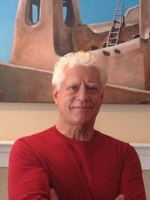
My Red-Tailed Hawk
by Dan Cardoza
Dan lives a few short blocks from the American River in the Sacramento River Watershed.

I have only seen a glimpse of him
now and again.
The fat dove’s distraction is why he comes
& in a feathery puff the dove is gone.
He flies like a scythe through the deepest blue furrows
in my backyard just above the trees.
Zeus would have worshiped him.
I spot him midday in the higher branches in the large
valley oak tree that covers half my yard
with its crooked summer shadows.
He glances down at what he can see of me
disdaining the gravity I am content to live with.
But mostly he has no thoughts;
his skull's religion is silence.
If I were small enough, it's my winged heart
he would be savoring.
Previously published in Nature Writing
© Dan Cardoza

Cubicle
by Anthony Borruso
Anthony grew up on Staten Island, where he lived a block away from the salt marsh and beach grass of Gateway Beach. He now lives in Indianapolis just south of where the White River curls into Broad Ripple Park.

No tie noosed round my throat, no
attaché case at the end of my arm
like an anchor. I’m just the boy
my mother measured on the closet door,
the one who swallowed a handful
of pomegranate seeds and was made
to stay in this body twelve months
out of every year. No cubicle assigned
to me except for this bone-box
my brain came in, ivory confine
of the mind; if I must go to the office—
give me a mahogany desk and plant
it out by the pines, top it with moss
and scotch decanter. Let there be
a mail-boy blooming acne, a secretary
sheathed in primrose. Conferences
of blackbirds and that great machine
the sky pumping out its endless blue
until up on a rope comes the moon.
Sure, this job might be a dead-end,
but when I clock out I’ll exit
through a door in the grass.
© Anthony Borruso

Cry for Help
by Sean Tierney
Sean lives along St. Lucie River, part of the larger Indian River Lagoon which, unfortunately, is routinely pumped with millions of gallons of polluted water and toxic algae by The Army Corps of Engineers in an attempt to reduce pressure on the dams of Lake Okeechobee.

few things communicate
as absolutely as this fly
caught between my window
and the screen
there is simply no room
for misinterpretation
© Sean Tierney
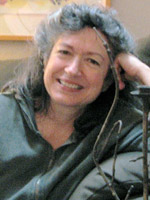
Lament for the Flowering Pear Tree
by Susan Kelly-DeWitt
Susan lives in the Lower Sacramento Watershed, about two miles from where the Sacramento and American Rivers meet.

It resembles
a crucifixion--now that the men
in their helmets, their bucket-trucks
have come
and gone, and the severed limbs
have fallen, and the leaves
have been cleared,
and the few remaining
branches sag
into the humid
dusk.
What is done cannot be
undone, the inner priest
pronounces.
We paid. It was necessary
to save what might be lost
in a sudden breaking
away,
to guard the passers by
who sheltered briefly
in its shade.
Soon the stars will come out to grieve
and spangle
the cold night
sky above the tree's fresh
wounds.
© Susan Kelly-DeWitt

Close to Home
by David M. Hoza
David got to know Bachechi Open Space in Los Ranchos, New Mexico, the winter he sold his home of 20 years. He travels year around and enjoys a visit to Bachechi whenever he’s close.

There’s this guy over off Alameda on the north side of Bachechi that sells little Bonsai trees out of his van. I see him there every day, sorting out his creations on the makeshift shelves he’s brought with him, in a vacant lot by the side of the busy road. He’s always sitting with a shelf in front of him, as the wind from the traffic—or the more malevolent winds of spring—threaten to blow him and everything he’s dragged outside away. Who knows how many times I rode right past without even seeing him. For months I biked past wondering what the hell brought him to this point in his life; this place. I’ve hardly ever seen anyone stop to buy anything. Once in a great while, maybe. Yet day after day, month after month he’s in the same place doing the same damn thing time after time.
Across the street from where he sits is the north side of Bachechi Open Space. Forever I’ve wondered what the difference was between an open space and a park. They both have trees. They both have ponds. They both have trails and benches and pathways. I got so curious one day I decided to have a look. All through the open space there are these interpretive plaques that describe the natural history of the place. The different plants and trees, the hummingbirds and squirrels; especially the waterfowl that overwinter there. It turns out that the central Rio Grande Bosque, as it’s called—the great riparian area on the west side of Albuquerque through which the Rio Grande flows on its way down from the San Juan Mountains in southwestern Colorado—is a central flyway for all sorts of birds on their way to and from Canada year after year. The river passes between Texas and Mexico on its way to the Gulf.
When I think of a park I always think of the Frederick Law Olmsted tradition, with great attention to planning, detail and selection of plants based primarily on their beauty and popularity, rather than their native stature. Olmsted designed his parks for the enjoyment of the people, while the open space is—as multiple displays in the education center point out—a sort of hybridized attempt to return fragments of the landscape to something somewhat like what existed before the first round of modern development usurped the grounds for commercial production. Pampas grass, reeds; honey locust trees, screwbean mesquite and Rio Grande Cottonwoods pepper the open space, suggestive of what might have been.
The Bachechi story goes deeper than that. For years since the early 1900s, an Italian family by the name of Bachechi farmed there. Water was plentiful owing to diversion canals from the free- flowing Rio, and Bachechi knew enough about exotics to plant a successful grove of pecan trees. The old grove still bears bushels of nuts that the birds pick through in fall. Like most modern, mechanized, commercial operations, the farm left its share of toxic waste. Underground tanks leached out into the soil. Oil, diesel and grease—from tractors, trucks and other farm equipment, cleaned and serviced on the property—contaminated the soil before pollution of that kind became alarming. After old man Bachechi died, the farm defaulted to just another piece of real estate, held and traded like a card in a poker game.
Having all that history under my belt while walking the shaded paths through the trees may not change anything, but I like the perspective it’s given me, and I like going there all the more. I like being able to name the trees and plants and things as I see them. It’s become like a second home to me.
Meanwhile I kept wondering about the Bonsai guy. Whatever brought him to this particular place, and what’s kept him here? As it sometimes does, my curiosity got the better of me, and one day I pulled over to the side of the road and said hello. Things were kind of awkward at first. I knew what I wanted to ask him, but suddenly it didn’t feel right just blurting it out, grilling him for answers. We talked a bit. He was far more attentive to the day than I am. He noticed all the subtle peculiarities of the season and proceeded to share with me the seasonal goings on in the open space. There was so much that I hadn’t noticed, though when he mentioned the different things there were to see and hear I began to realize all the things I’d been missing. He put it together for me in an ever-evolving mural, a mosaic, changing practically day by day. It’s fascinating when you really get the chance to know the neighborhood.
He told me to come back at dusk and he’d show me something else. A full moon rose above the peaks just before dark, and the kinds of light transitioned from the hard brightness of day with its long shadows leaning east to the soft creamy light between long shadows leaning west. As we toured the perimeter and then entered into the heart of the open space, he imagined for me in great detail the lay of the land back when it had been a productive farm: the way each farm building sat, how it looked, down to the details of what sat on the porch, the out buildings, the pig pens, the chicken coops. He pointed out where a tire swing once hung in the yard next to the foreman’s house from a big branch of an old cottonwood tree, now long gone. He talked so intimately of things, I said it was like he lived here, and his eyes grew large and bright and he broke into a smile.
In fact, he’d grown up there. He was indeed the foreman’s son. His dad had raised him to believe he too would one day become the caretaker of all this, but then old man Bachechi had died and his offspring divided the spoils like a jar of wheat pennies, dismantling the great organic thing it once was, lying in wait for the encroachment of the city and skyrocketing land prices. His dad didn’t know anything else, and there was still plenty of farm work around if you really knew what you were doing, though it didn’t pay much.
The Bonsai guy felt much like his dad. Though they’d never owned the place, it was all he and his dad had ever known as home. His mom had died in childbirth. The Bonsai guy took a job when he was a teenager in a pizza place nearby and eventually managed the place, then bought it and ran it himself. His dad was fast closing in on a hundred years old. He lost the pizza place when the neighborhood finally built out and the new generation of locals abandoned tried and true pizza for another new microbrewery. He, for all he’d been through, was still living as best he could in the place he’d been raised.
I stop in on him now and again, especially when I need a little jog in my perspective, to see what’s what. It turns out the little trees he bonsais are actually native sage. He pays a kid he knows to bring them down off the West Mesa. We especially like to meet up on moonlit nights and stroll beneath the honey locusts and the cottonwoods and the mesquites, after they’ve unfurled their dense canopies of leaves. Discussing things like a pair of old-school naturalists or philosophers. He’s read nearly every issue of National Geographic I have. It makes me think we’re two of the worldliest people I know, though I haven’t set foot outside the neighborhood in I don’t know when, and he, as it turns out, never left.
© David M. Hoza

Salina, Kansas
by Gene Berson
Gene lives in the northern California foothills in the Yuba River watershed. Everyone goes to the river. Like a temple, with its falls its rapids its green pools, it seems to restore everyone in a personal way. We feel our kinship through it.

I couldn’t get a ride out of town
I couldn’t get a ride
back into town, and it was cold
getting dark
so I went into a wrecking yard
crawled into the back seat
of a ’39 Chevy
when I opened my eyes
a caravan of dew
was crossing a velvet terrain
back of the old front seat
each drop quivering under its burden
of morning sun
when I finally got a ride
from a farmer and his wife
he spoke to me
with respectful affection
he was from world war two
could see I was in the infantry
assumed I was like a son
he’d likely never see again
and although he never did
I think of him now
a father I didn’t know I had
his war was over, however
it was still playing inside him
but we both knew another war
was coming
his eyes passed something into mine
a cartridge of grateful sorrow
locked into the breach of time
chance had thrown us together
we met in a cosmic synapse
so something transferred
but it was too late
for a repeat, fighting for your country
was already obsolete
I now realize how rare it is to see
the caravan from afar
apart from it
lying in the back of an old car
in a wrecking yard in kansas
in winter
without a dollar in your pocket
it came with a feeling of happiness
being solitary, able to watch
each wobbling dewdrop
carry its sack of sunlight
across that old velvet seat
they don’t make upholstery like that now
its musty but not unpleasant smell
a residue from the nineteenth century
textile industry, a world that has gone
no one could avoid the war that came
whether he fought in it
or fought against it
and even though I lucked out
I became a refugee from civilization
and caught up with the caravan of dew
I saw that morning
I could have been anyone
anywhere
but I was there
because I was luckily broke
and stuck
I became my father
and gave myself a ride
it seems, as Lily Tomlin said
We’re all in this
alone
but when I think
of the caravan of dew
I’m part of everything
—that’s the caravan
I’m still traveling in
and will travel in until I die
and even then . . .
but if you’re nostalgic
for romantic glory, and want to die
to prove how much you love
your country, which doesn’t exist,
or even for your brothers-in-arms
I recommend getting between a whale
and a Russian harpoon
and stick up for a peaceful
Leviathan
that is already dying, incidentally
of plastic plankton
there’s no shortage of things to fight for
when you’re a drop of dew full of sunlight
which you are
© Gene Berson

By August
by Gene Berson
Gene lives in the northern California foothills in the Yuba River watershed. Everyone goes to the river. Like a temple, with its falls its rapids its green pools, it seems to restore everyone in a personal way. We feel our kinship through it.

black oaks are already discarding
bits of crisp lace, skeletons of worm-eaten leaves
(some damp chamois-colored ones will stubbornly hang
motionless, like defeated prayer flags
in the mist of late autumn ravines)
rivers slacken, scummy algae
cloud the bottom, putrid
water, dark as tea steeped too long
trapped in miniature granite tarns
reflects sky, a bluish cataract, in a sick
oily rainbow of decaying leaves
the river thins
exposing rocks like refugees
to the barren glare. . . .
Incandescent cumulous clouds tumble up
into the bruised sky.
We sense the end of our cycle
yearn to freeze them in place
watch in silence.
The curtain strangely rises
on what’s to come.
We stay in that silence as long as we can.
We hope for everything
but are given a splendid day.
© Gene Berson

Pebble Creek, Montana
by Ingrid Keriotis
Ingrid lives in the Wolf Creek watershed not far from the creek’s headwaters at 3,000 feet in the foothills of the Sierra Nevada. Her landscape is one of abundant pines and cedars, bobcats and mule deer, and a rich red dirt that sticks like crazy to boots in winter.

I need to get ready to teach
but I’m in a room cluttered and small
with no eraser for the scribbled-on whiteboard.
I walk between battered tables in dim light, squinting.
Then, suddenly, oddly, my name is called.
My eyes flutter open.
I’m awake but so groggy it hurts.
“Quick,” I hear, “it’s a moose.”
I struggle with the zipper and poke my head
out of the tent into the cool air.
I see him, ambling along the stream
with awkward grace.
Dark and tall, he steps among the young willows,
legs bending like sticks in water.
The morning meadow awakens
into wet exuberance
and my ambition is replaced by elements:
hooves in grass,
a brightening sky, a ceremony of birds.
© Ingrid Keriotis

Walking at Night
by Elizabeth Poliner
Elizabeth lives near Tinker Mountain in the Blue Ridge range of Southwest Virginia.

Sometimes the horses grazing
in the nearby pastures come to the fence
and we talk. Or I do, and they seem to listen.
Last night, the pastures empty,
I walked to the stables,
stood before one extraordinary body
then the next, massive, lean,
muscular, gleaming
as if just polished, muzzles
pressed forward as I approached,
and me too, pressing forward,
eager for another visit. In the dark
I have told the horses
my fears and dreams. Have told them
I am leaving soon. Said
hello, sweet to see you,
have reached out to them
as they gather close, wait in turn
to nuzzle. Someone has loved these horses,
who come near so readily
to calm a stranger,
offering only the sugar
of her prayers. That we are never alone
is something I want to believe
and have come to believe, while alone,
deep in the night,
taking the path
that leads to the horses.
Reprinted with permission from The Sun.
© Elizabeth Poliner